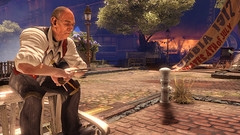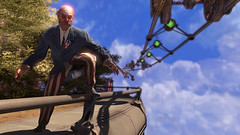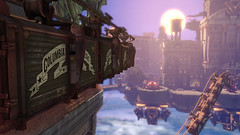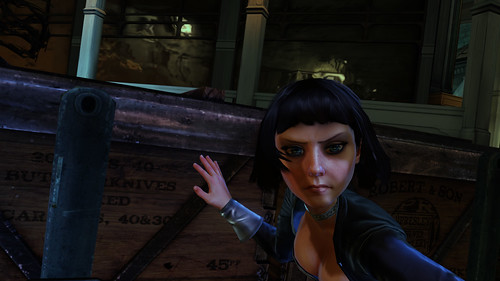Last week, Irrational Games introduced BioShock Infinite to the world with a startling cinematic trailer set in the clouds far above Earth. Since then, I’ve seen BioShock Infinite in action, and the first-person gameplay featured numerous hallmarks of BioShock as well as intriguing new elements.


In the gameplay scenario I saw, protagonist Booker DeWitt explored the floating city of Columbia before battling a large mob of murderous Columbian citizens using shotguns and hunting rifles. Booker wielded supernatural powers as well, hurling lightning, telekinesis, and flesh-eating crows ala Hitchcock’s The Birds. After locating Elizabeth, the mysterious young woman at the heart of Columbia’s internal conflict, Booker’s powers grew exponentially. Channeled through Elizabeth, lightning bolts became swirling thunderstorms and telekinesis ripped the environment to tatters.
I spoke with Irrational Games creative director Ken Levine to learn more about BioShock Infinite’s gameplay, similarities and differences compared to the original BioShock, and how the suspended city of Columbia presents new opportunities for first-person combat.

Sid Shuman: You often described BioShock as a shooter first and foremost. Do you consider BioShock Infinite to be a pure shooter? Has it evolved?
Ken Levine, Creative Director, Irrational Games: One of the reasons we were so specific about defining BioShock as a shooter was because it was so strange. It was such an odd beast that we thought [defining it as a shooter] helped ground people’s understanding of what they’d be doing. But I think people now understand what BioShock is, so I’m less focused on that now. People understand that it’s a shooter, but that it’s a particular kind of shooter that’s unique to what Irrational Games and what we do. It’s a shooter that has quite a lot of expressiveness outside of the shooting as well.
SS: On the combat side, will you be keeping somewhat consistent with the ground rules and basic mechanics of BioShock?
KL: The previous games gave players a lot of tools, but there was a tendency for encounters to have a lot of similarities: narrow corridors and one or two enemies. So the tendency was for tools like the Electro-Bolt and shotgun to be commonly used because they were extremely effective. So the sniper rifle weapon (the crossbow) and the area-of-effect attacks were less effective and less used.
We wanted to make sure we had a broad range of weapons and powers [for BioShock Infinite], and that the environments and challenges demanded those weapons and powers. So there are a ton of interior spaces in the game that will feel like a traditional BioShock spaces, very intimate. But we also focus on spaces that are quite different from what you’ve seen in a BioShock game: huge, open, outdoor spaces with broad ranges. And instead of one or two enemies, you might fight 15 enemies at one point.


We’re using an entirely new graphics engine — there’s no shared code or assets with any previous BioShock game, though it’s based on Unreal 3.0 technology. The reason we had to go with a new engine, and one of the reasons development has taken awhile, is because we couldn’t do what we wanted to do otherwise. We couldn’t do this kind of scale, or the scenes on the Skylines where you’re in combat while traveling at 60 miles per hour, or scenes where you’re fighting 15 enemies at once.
And something like a sniper rifle now make a lot of sense! It becomes meaningful now that we’ve changed the dynamics of the environment. Vertical movement across big, broad spaces and multiple enemies who work together against you — these are things you haven’t seen in a BioShock game before.
SS: Who’s the hulking character in the trailer, the one who looks a bit like the Big Daddy from BioShock?
KL: He’s what we call an “Alpha,” I wouldn’t view him as a new Big Daddy. Internally, we refer to three classes of characters: Alphas, Betas, and Gammas. Betas are the more traditional BioShock enemy who sees you and attacks right away. Gammas sort of do their own thing and may get drawn into combat. The Alphas are a class of badasses in the city who are very powerful on their own, but also can augment the abilities of other characters — they can act as leaders for them. We’ll be releasing more information on how they actually work later, but generally, they’re tougher and will work in a strategic fashion with other characters.

SS: It wouldn’t appear that Adam and Plasmids play a role in this universe, and yet we see Plasmid-like abilities, including powers that look like Telekinesis and Electro-Bolt…
KLYou’ve seen a range of powers, and some are intentionally familiar because we wanted to show how they are differently applied in this world, and how they interact with Elizabeth. What Elizabeth brings to the table is her narrative role as a character who is with you. Elizabeth provides opportunities to do things on a grander scale, but none of it will get in the way of you approaching the game with your own tools.
SS: Elizabeth has been trapped in Columbia since she was five. Is she a constant companion during gameplay?
KLShe will be coming in and out of the story at various points. There’s a character who is very focused on keeping the two of you separated. There are various events that bring the two of you together, or pull you apart, during the course of the story.
SS: I saw a poster for “Saltinstalli.” Who is that? Is he a political figure?
KL: Yes, he’s a political figure in Columbia. He’s representative of a certain point of a view in the city — a prevalent point of view. When you first encounter him, he’s giving a speech to nobody.
